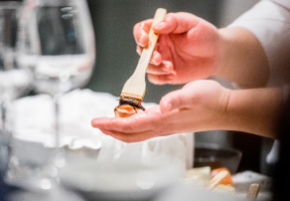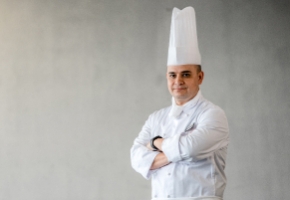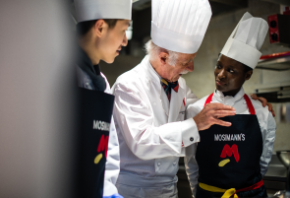- About
- Programs
- Campus Life
- Career Services
- Admissions
- News & Events
- Alumni
What Is a Croquembouche? Recipe, Variations, and More
Learn how to make a croquembouche, a stunning French dessert tower made from choux pastry. Explore techniques, variations, and pro tips.
Key Takeaways
- Croquembouche is a traditional French dessert made of cream-filled choux puffs stacked into a cone and held together with caramel.
- Croquembouche is both a technical challenge and a showpiece, often featured at weddings, celebrations, and culinary school exams.
- Making a croquembouche requires precision in choux pastry, pastry cream, sugar work, and artistic presentation.
Imagine walking into a wedding or a festive French gathering, and at the center of the table stands a towering cone of golden cream puffs, shimmering with threads of caramel. That stunning creation is called apièce montée or croquembouche, a dessert made to impress.
Its tall structure, glossy finish, and delicate details turn it into a true centerpiece. Every bite offers a light crunch followed by smooth pastry cream, making it as delightful to eat as it is to admire. For pastry chefs and students, building a croquembouche is an exciting test of technique, timing, and creativity that draws people in again and again.
What Is a Croquembouche?
A croquembouche, the most common French wedding cake, is a traditional dessert made from cream-filled profiteroles stacked into a tall cone and bound together with caramel. The name originates from the French phrase “croque en bouche,” meaning “crunch in the mouth,” which perfectly describes the experience of biting into its crisp caramel shell and soft pastry center.
This dessert originated in a French patisserie during the late 18th to early 19th century and quickly became a symbol of celebration and culinary artistry. The structure is usually built around a cone mold, with each choux puff carefully placed and secured with hot sugar.
Once assembled, it’s often finished with spun sugar, sugared almonds, or even edible flowers. More than a dessert, a croquembouche is a showpiece often featured at weddings, baptisms, and other formal occasions. Creating one takes time, patience, and confidence with sugar work, which is why it remains a signature challenge in the world of fine pastry.
Key Components of a Croquembouche Tower
A croquembouche tower is made up of several key components, each playing an essential role in structure, flavor, and presentation. Together, these elements turn a simple idea into a delicious centerpiece.
Start Your Culinary Journey
Learn the art of cooking in a world-class environment
- Choux pastry forms the base. These light, hollow dough balls (also called profiteroles) are baked until golden and crisp, providing the signature crunch and the shape needed for stacking.
- Pastry cream is piped inside each puff, adding richness and flavor. Classic vanilla is common, but other flavors like chocolate, coffee, or praline can also be used.
- Caramel or sugar glue holds the tower together. The hot sugar hardens quickly, creating both stability and a crackly coating that enhances the texture and visual appeal.
- Decorative elements bring the final wow factor. Spun sugar, sugared almonds, fresh flowers, or even gold leaf can be used to dress up the croquembouche, transforming it from dessert to showstopper.
How to Make a Croquembouche
As stunning as it is to look at and as irresistible to taste, making a croquembouche is surely considered intimidating. With patience and thoughtful planning, however, it becomes an achievable goal.
The process involves several steps: preparing the choux pastry, filling the puffs with pastry cream, making caramel, and carefully assembling the tower before decorating it. It is a project that challenges your finesse, timing, and attention to detail.
Therefore, it is important that, rather than rushing through it, you treat the experience as both a creative outlet and a valuable opportunity to grow your pastry skills.
Prepare the choux pastry
Making choux pastry starts with simple ingredients: butter, water, flour, and eggs.
Begin by melting the butter with water in a saucepan, then add flour and stir vigorously until the dough pulls away from the sides. Allow it to cool slightly before beating in the eggs one at a time until the mixture becomes smooth and glossy. The dough should be firm enough to hold shape but soft enough to pipe.
Pipe small, uniform rounds onto a baking sheet, spacing them evenly. Uniform size is essential for even stacking and stability later. Bake in a hot oven until golden and fully dried out, which prevents collapse when filled. The puffs should be light and hollow inside, with a crisp shell that holds up well to cream and caramel. Proper baking ensures structure, and careful shaping sets the foundation for the tower ahead.
Make the pastry cream filling
Pastry cream, or crème pâtissière, is a smooth custard made from milk, sugar, egg yolks, cornstarch, and vanilla.
To prepare the cream, start by heating the milk until warm, then slowly whisk it into a mixture of egg yolks, sugar, and cornstarch. Return everything to the heat and stir constantly until the mixture thickens into a creamy, pudding-like consistency.
Remove from heat, stir in vanilla, and cover with plastic wrap directly on the surface to prevent a skin from forming. Chill completely before using. This is an important step because warm pastry cream can cause the choux to become soggy.
Once chilled, transfer the cream to a piping bag fitted with a small tip. Use the tip to gently fill each puff from the bottom or side, stopping once the pastry feels full and slightly heavier. Even distribution ensures each bite is balanced, and the piping process helps keep things neat and consistent.
Assemble the tower
To build a croquembouche, begin with a solid, flat base. Some use a cone mold to guide stacking, but it is also possible to freehand the shape. Start by dipping the filled puffs lightly into warm caramel and placing them in a circle at the bottom, forming a sturdy foundation.
Work in layers, using caramel as the glue between each puff. As the structure rises, place each profiterole at a slight inward angle to form the signature cone shape. Because caramel hardens quickly, make sure to work with focus and purpose. If it becomes too stiff, gently reheat it to regain fluidity.
Stability here is everything. A wide, balanced base and uniform stacking help prevent collapse. It also helps to slightly flatten the bottom of each puff before placing it to create more surface contact. Step by step, the tower takes shape, held together by technique, timing, and caramel.
Finish and decorate
Once the tower is complete and stable, it is time to add the finishing touches. Traditional croquembouche decorations include spun sugar draped like golden threads, sugared almonds for crunch, and edible flowers for elegance. Some add small candies, chocolate accents, or festive ribbons for themed occasions.
Before decorating, ensure the caramel has cooled and set fully to prevent the decorations from sliding or melting. If using spun sugar, create it by quickly whisking caramel into fine strands using two forks or a whisk and then draping them over the tower.
For those new to croquembouche, a base cone mold offers extra guidance and can be covered with parchment to prevent sticking. Once decorated, let the tower rest in a cool, dry place. Avoid refrigeration, which can affect texture. The final result is a striking centerpiece—crisp, sweet, and sculptural—ready to steal the spotlight at any celebration.
Croquembouche Variations and Flavor Twists
While the classic croquembouche is filled with vanilla pastry cream and finished with spun sugar, there are endless ways to give this iconic dessert a creative spin. Modern pastry chefs often experiment with flavored fillings, such as rich chocolate ganache, hazelnut praline, coffee cream, or fruit-infused custards like raspberry or passionfruit. Each variation adds a unique layer of flavor while preserving the traditional structure.
Toppings can also be reimagined. Try drizzling the tower with flavored caramel, dusting it with powdered freeze-dried fruits, or adding a shimmer of edible gold for extra elegance. Colored sugar or decorative sprinkles can bring a playful or festive feel.
For themed events or holidays, consider matching the croquembouche to the occasion. A winter version might feature white chocolate drizzle and sugared cranberries, while a springtime tower could be dressed in pastel flowers and lemon cream. Birthdays, weddings, or holiday gatherings all offer inspiration for turning the croquembouche into a personal and memorable centerpiece.
How to Serve a Croquembouche
A croquembouche's presentation and serving can be equally impressive, but maintaining the tower's beauty while letting guests enjoy it calls for a little skill and attention to detail.
Unlike a traditional cake, a croquembouche is not meant to be sliced. Instead, guests pull individual cream puffs from the tower by hand, usually starting from the top or outer edge. The caramel holding everything together is strong enough to keep the structure intact during serving, as long as it is approached gently and one puff is taken at a time.
For particularly firm caramel or tightly packed puffs, a hot knife or kitchen torch can help loosen sections without damaging the rest of the tower. This technique is often used by professionals during formal events to make the first few servings easier.
Using small dessert tongs or food-safe gloves adds a cleaner, more elegant touch, especially in buffet settings or large gatherings. Regardless of how it’s served, presentation plays a big role. Keeping the croquembouche on a decorative base or platter maintains its visual appeal while guests enjoy each delicate piece.
Why Pastry Students Learn to Make Croquembouche
Making a croquembouche is a rite of passage for many pastry students, especially those studying at Culinary Arts Academy Switzerland (CAAS), where tradition meets technique in a professional kitchen setting.
At CAAS, students enrolled in the Swiss Diploma in Pastry Arts program explore the world of fine pastry, including the making of intricate desserts, which stand as a true test of pastry skill, discipline, and creativity.
Making croquembouche combines several sophisticated techniques into a single dish, which is why pastry students all over the world learn how to make it. It requires mastery of choux pastry, smooth and stable pastry cream, and precise sugar work.
The process teaches timing, as each step must be executed in the correct order and at the right temperature. Students also develop a sharp eye for structure and presentation, learning how to build a visually striking tower that holds its form.
Often used in culinary school exams and final projects, croquembouche challenges students to apply everything they have learned, from the science of baking to the art of presentation. It helps them build confidence and gain a deeper understanding of the skills needed in professional pastry kitchens.
Skills, Creativity, and a Tower of Pastry
Croquembouche is both a challenge and a masterpiece in the world of pastry. Its towering structure, delicate components, and striking presentation make it a symbol of technical skill and creativity. For aspiring pastry chefs and passionate home bakers, mastering this dessert is a rewarding way to showcase finesse and dedication.
Learning to create a croquembouche demonstrates a strong command of pastry fundamentals and advanced techniques. At CAAS, through our programs, students gain the training and confidence needed to bring such ambitious desserts to life.
If you are serious about pastry, CAAS is the place to start your journey.
Frequently Asked Questions
Why is croquembouche hard to make?
It requires precise timing, consistent choux pastry, stable fillings, and careful sugar work to build a tall, balanced structure without collapsing.
What's the difference between a profiterole and a croquembouche?
A profiterole is a single cream-filled choux pastry, while a croquembouche is a large tower made by stacking multiple profiteroles with caramel.
How long can you store a croquembouche before serving?
Ideally, serve it within 4 to 6 hours to keep the pastry crisp and the caramel stable.
Interested in studying at CAAS? Download our brochure to learn about our programs!























